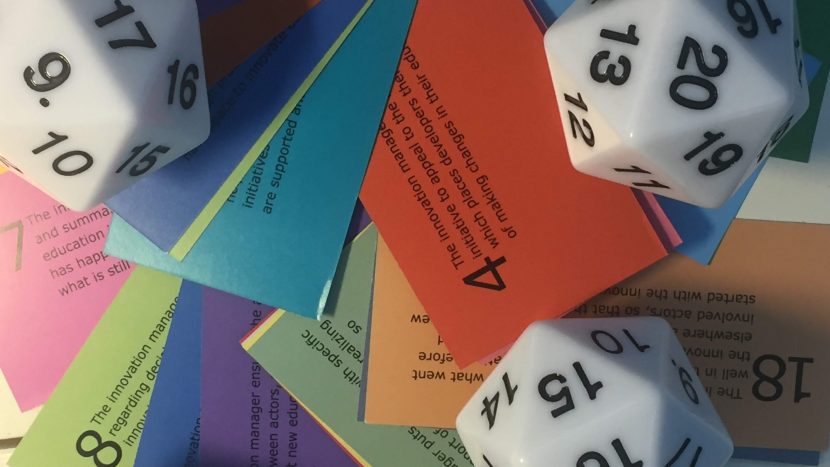Remco Coppoolse & Sander Toby
1. Introduction
The complexity of educational innovation requires a different approach to innovation than has been customary so far. In the last six years in our consultancy and research work, we have developed a model that allows you to better understand the progress in educational innovation and to intervene in the event of stagnation. That model is based on dynamic multi-actor thinking in complex systems, which means as much as in educational innovation that the process is determined by the interaction between all the actors involved and that not one single actor can determine the process. And that instead of only working ‘head first’, you are also prepared to take a step back in the event of a stagnation, review the agreements made in a previous round and, if you wish, reconsider, so that in a subsequent phase you can more easily agree on that phase. In research we found a number of work rules that seemed to apply in a number of the cases that were investigated. However, despite the fact that this model and its work rules seem to prove its value in practice, the real validation has been limited. Our impression is that further refinement and validation are needed to further enhance the model, making it even more suitable for a broader spectrum of educational innovations.
Figure 1. Dynamic innovation management in educational innovation (Coppoolse, 2018)
2. Method
To further investigate the usability of the model, we asked participants in a workshop at the Eapril conference in 2019 to make a drawing of an exemplary moment of stagnation in their educational innovation. We then asked each of the 4 tables to choose an innovation that appealed most to the imagination at the time or was ‘hot’ at the time. By throwing a dice, they chose a work rule with which they reflected on the exemplary moment. The participants noted the findings and placed them on twitter (#dimo19). We presented the results on a twitter wall on the screen. We analyzed the results for fragments of usability and possible improvement proposals for the model.
3. Results
Although one of the participants mentioned that the chosen work rule did not help in a better understanding, it was generally noticeable that the session led to surprising insights into the chosen educational innovation, despite the wide variety of examples of innovation and the absolute randomness of the chosen work rule.
One of the participants found in the reflection a confirmation of the chosen approach, and in addition the DIMO approach offers a routing for future innovations: “… It helped comfort what we are already doing …”, followed by: “… These are stepping stones for every innovation … “One of the participants indicated that DIMO offers an alternative view of their own work:” … working with DIMO shows us alternatives. Another way to think about your own work. Others filled in that other way of thinking a little further: “… Talk about the process and be clear about our own feelings …” Working with DIMO apparently led to the realization that the signals they were aware of in the process of educational innovation should be shared because it can benefit the process.
Other participants described more specific insights that this method had delivered. In one of the cases it turned out that there is actually no owner of the process. In another case the question arose as to whether the trajectory that was started should actually be called an innovation: “… The question here is we are innovating or just improving an existing program …” moreover, that observation led to the question of whether to rig a solid project organization parallel to the line organization was such a happy choice.
The most meaningful feedback was from one of the participants who found a language and a way of looking at working with DIMO to be able to interpret processes and events that would otherwise remain implicit. “… In my work, the DIMO model provides me with a tool to get the club on board in the boat or vice versa. For me it gives words to moments that are elusive in innovation. I look forward to delving into it and applying it … ”
4. Conclusions
We organized a reflection workshop on working with the DIMO model to get an impression of the usability of the model and possible suggestions for refining or refining the model. The usefulness of working with the DIMO model is that it (1) offers an action alternative for those involved in educational innovation, (2) gives the opportunity to reflect on parts of an innovation process and (3) offers a set of instruments and language to see through and influence elusive processes. Further research into what these insights yield in educational innovation practice, and which phases or aspects of educational innovation are primarily focused can offer starting points to refine the model.
However, despite the fact that the reactions of the participants were not an immediate reason to refine the model, we ourselves found in the preparation of the workshop that a number of work rules are valid, but have been formulated too elaborately. In addition, a number of work rules that are linked to a specific piece of the model seem to apply in several places.
In short, based on the reflection on the model, it appears to be an interesting action alternative for educational innovation and the instrument offers instruments and language to be able to interpret unseen events. Further research in the practical application and with that further refinement can further strengthen this practical relevance.
Literature
Coppoolse, R. (2018) werkregels voor innovatiemanagers. Hoger onderwijs in een versnelling. Academisch Proefschrift, Universiteit Utrecht, Utrecht.
Copppoolse, R. & Toby, S. (2019). Weg van de projectreflex. IPMA-NL.
Van Delden, P.J. (2009). Samenwerking in de publieke dienstverlening. Ontwikkelingsverloop en resultaten. Academisch Proefschrift, Delft, Eburon

